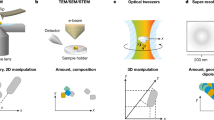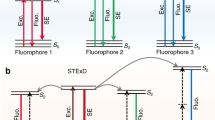Abstract
Imaging at the single-molecule level reveals heterogeneities that are lost in ensemble imaging experiments, but an ongoing challenge is the development of luminescent probes with the photostability, brightness and continuous emission necessary for single-molecule microscopy1,2,3,4,5,6. Lanthanide-doped upconverting nanoparticles overcome problems of photostability and continuous emission7,8,9,10,11,12 and their upconverted emission can be excited with near-infrared light at powers orders of magnitude lower than those required for conventional multiphoton probes13,14. However, the brightness of upconverting nanoparticles has been limited by open questions about energy transfer and relaxation within individual nanocrystals and unavoidable tradeoffs between brightness and size15,16,17,18. Here, we develop upconverting nanoparticles under 10 nm in diameter that are over an order of magnitude brighter under single-particle imaging conditions than existing compositions, allowing us to visualize single upconverting nanoparticles as small (d = 4.8 nm) as fluorescent proteins. We use advanced single-particle characterization and theoretical modelling to find that surface effects become critical at diameters under 20 nm and that the fluences used in single-molecule imaging change the dominant determinants of nanocrystal brightness. These results demonstrate that factors known to increase brightness in bulk experiments lose importance at higher excitation powers and that, paradoxically, the brightest probes under single-molecule excitation are barely luminescent at the ensemble level.
This is a preview of subscription content, access via your institution
Access options
Subscribe to this journal
Receive 12 print issues and online access
$259.00 per year
only $21.58 per issue
Buy this article
- Purchase on Springer Link
- Instant access to full article PDF
Prices may be subject to local taxes which are calculated during checkout





Similar content being viewed by others
Change history
24 March 2014
In the version of this Letter originally published online, in Fig. 2b caption, the last two sentences were missing. This error has now been corrected in all versions of the Letter.
References
Thompson, M. A., Lew, M. D. & Moerner, W. E. Extending microscopic resolution with single-molecule imaging and active control. Annu. Rev. Biophys. 41, 321–342 (2012).
Auzel, F. Upconversion and anti-Stokes processes with f and d ions in solids. Chem. Rev. 104, 139–173 (2004).
Haase, M. & Schafer, H. Upconverting nanoparticles. Angew. Chem. Int. Ed. 50, 5808–5829 (2011).
Buenzli, J-C. G. Lanthanide luminescence for biomedical analyses and imaging. Chem. Rev. 110, 2729–2755 (2010).
Park, Y. I. et al. Nonblinking and nonbleaching upconverting nanoparticles as an optical imaging nanoprobe and T1 magnetic resonance imaging contrast agent. Adv. Mater. 21, 4467–4471 (2009).
Cohen, B. E. Biological imaging: beyond fluorescence. Nature 467, 407–408 (2010).
Wang, F. et al. Simultaneous phase and size control of upconversion nanocrystals through lanthanide doping. Nature 463, 1061–1065 (2010).
Wu, S. et al. Non-blinking and photostable upconverted luminescence from single lanthanide-doped nanocrystals. Proc. Natl Acad. Sci. USA 106, 10917–10921 (2009).
Ryu, J. et al. Facile synthesis of ultrasmall and hexagonal NaGdF4: Yb3+, Er3+ nanoparticles with magnetic and upconversion imaging properties. J. Phys. Chem. C 114, 21077–21082 (2010).
Gnach, A. & Bednarkiewicz, A. Lanthanide-doped up-converting nanoparticles: merits and challenges. Nano Today 7, 532–563 (2012).
Van der Ende, B. M., Aarts, L. & Meijerink, A. Lanthanide ions as spectral converters for solar cells. Phys. Chem. Chem. Phys. 11, 11081–11095 (2009).
Nam, S. H. et al. Long-term real-time tracking of lanthanide ion doped upconverting nanoparticles in living cells. Angew. Chem. Int. Ed. 50, 6093–6097 (2011).
Jauffred, L. & Oddershede, L. B. Two-photon quantum dot excitation during optical trapping. Nano Lett. 10, 1927–1930 (2010).
Schuck, P. J., Willets, K. A., Fromm, D. P., Twieg, R. J. & Moerner, W. E. A novel fluorophore for two-photon-excited single-molecule fluorescence. Chem. Phys. 318, 7–11 (2005).
Wang, F. et al. Tuning upconversion through energy migration in core–shell nanoparticles. Nature Mater. 10, 968–973 (2011).
Ostrowski, A. D. et al. Controlled synthesis and single-particle imaging of bright, sub-10 nm lanthanide-doped upconverting nanocrystals. ACS Nano 6, 2686–2692 (2012).
Schietinger, S., Menezes, L. D., Lauritzen, B. & Benson, O. Observation of size dependence in multicolor upconversion in single Yb3+, Er3+ codoped NaYF4 nanocrystals. Nano Lett. 9, 2477–2481 (2009).
Zhao, J. et al. Single-nanocrystal sensitivity achieved by enhanced upconversion luminescence. Nature Nanotech. 8, 729–734 (2013).
Moerner, W. E. & Fromm, D. P. Methods of single-molecule fluorescence spectroscopy and microscopy. Rev. Sci. Instrum. 74, 3597–3619 (2003).
Kramer, K. W. et al. Hexagonal sodium yttrium fluoride based green and blue emitting upconversion phosphors. Chem. Mater. 16, 1244–1251 (2004).
Suyver, J. F. et al. Upconversion spectroscopy and properties of NaYF4 doped with Er3+, Tm3+ and/or Yb3+. J. Lumin. 117, 1–12 (2006).
Yi, G. S. & Chow, G. M. Synthesis of hexagonal-phase NaYF4:Yb,Er and NaYF4:Yb,Tm nanocrystals with efficient up-conversion fluorescence. Adv. Funct. Mater. 16, 2324–2329 (2006).
Chen, G. Y., Ohulchanskyy, T. Y., Kumar, R., Agren, H. & Prasad, P. N. Ultrasmall monodisperse NaYF4:Yb3+/Tm3+ nanocrystals with enhanced near-infrared to near-infrared upconversion photoluminescence. ACS Nano 4, 3163–3168 (2010).
Lim, S. F., Ryu, W. S. & Austin, R. H. Particle size dependence of the dynamic photophysical properties of NaYF4:Yb, Er nanocrystals. Opt. Express 18, 2309–2316 (2010).
Zhao, J. et al. Upconversion luminescence with tunable lifetime in NaYF4:Yb,Er nanocrystals: role of nanocrystal size. Nanoscale 5, 944–952 (2013).
Wang, F., Wang, J. A. & Liu, X. G. Direct evidence of a surface quenching effect on size-dependent luminescence of upconversion nanoparticles. Angew. Chem. Int. Ed. 49, 7456–7460 (2010).
Pollnau, M., Gamelin, D. R., Luthi, S. R., Gudel, H. U. & Hehlen, M. P. Power dependence of upconversion luminescence in lanthanide and transition-metal-ion systems. Phys. Rev. B 61, 3337–3346 (2000).
Chan, E. M., Gargas, D. J., Schuck, P. J. & Milliron, D. J. Concentrating and recycling energy in lanthanide codopants for efficient and spectrally pure emission: the case of NaYF4:Er3+/Tm3+ upconverting nanocrystals. J. Phys. Chem. B 116, 10561–10570 (2012).
Zeng, J. H., Su, J., Li, Z. H., Yan, R. X. & Li, Y. D. Synthesis and upconverstion luminescence of hexagonal-phase NaYF4:Yb, Er3+ phosphors of controlled size and morphology. Adv. Mater. 17, 2119–2123 (2005).
Downing, E., Hesselink, L., Ralston, J. & Macfarlane, R. A three-color, solid-state, three-dimensional display. Science 273, 1185–1189 (1996).
Zou, W., Vissser, C., Maduro, J. A., Pshenichnikov, M. S. & Hummelen, J. C. Broadband dye-sensitized upconversion of near-infrared light. Nature Photon. 6, 560–564 (2012).
Kannan, P. et al. Enhanced emission of NaYF4:Yb,Er/Tm nanoparticles by selective growth of Au and Ag nanoshells. RSC Adv. 3, 7718–7721 (2013).
Liu, Q. et al. Sub-10 nm hexagonal lanthanide-doped NaLuF4 upconversion nanocrystals for sensitive bioimaging in vivo. J. Am. Chem. Soc. 133, 17122–17125 (2011).
Deutsch, Z., Neeman, L. & Oron, D. Luminescence upconversion in colloidal double quantum dots. Nature Nanotech. 8, 649–653 (2013).
Acknowledgements
The authors thank M. Salmeron and R. Johns for discussions and comments on the manuscript, as well as A. Nievergelt and A. Mueller for assistance with data processing and visualization. P.J.S. acknowledges Bica for support. A.D.O. was supported by a fellowship from the National Institute of Biomedical Imaging and Bioengineering, under NIH Award F32EB014680. Work at the Molecular Foundry was supported by the Director, Office of Science, Office of Basic Energy Sciences, Division of Materials Sciences and Engineering, of the US Department of Energy (contract no. DE-AC02-05CH11231).
Author information
Authors and Affiliations
Contributions
P.J.S., B.E.C., D.J.M., D.J.G., E.M.C. and A.D.O. developed the idea for the project. A.D.O., E.M.C. and B.E.C. synthesized the nanocrystals. E.M.C. performed the kinetic modelling and simulations. D.J.G. performed the single-UCNP optical imaging, lifetime and spectroscopy measurements, as well as single-UCNP scanning TEM imaging. S.A. and M.V.P.A. provided TEM and analysis. J.J.U. provided in-depth discussions. E.S.B. and B.S. provided in-depth discussions and performed data analysis. D.J.G., E.M.C., B.E.C. and P.J.S. wrote the paper. All authors reviewed the paper.
Corresponding authors
Ethics declarations
Competing interests
The authors declare no competing financial interests.
Supplementary information
Supplementary information
Supplementary Information (PDF 5310 kb)
Rights and permissions
About this article
Cite this article
Gargas, D., Chan, E., Ostrowski, A. et al. Engineering bright sub-10-nm upconverting nanocrystals for single-molecule imaging. Nature Nanotech 9, 300–305 (2014). https://doi.org/10.1038/nnano.2014.29
Received:
Accepted:
Published:
Issue Date:
DOI: https://doi.org/10.1038/nnano.2014.29
This article is cited by
-
Bright single-nanocrystal upconversion at sub 0.5 W cm−2 irradiance via coupling to single nanocavity mode
Nature Photonics (2023)
-
Enhancing the upconversion efficiency of NaYF4:Yb,Er microparticles for infrared vision applications
Scientific Reports (2023)
-
Exploring luminescence quenching on lanthanide-doped nanoparticles through changing the spatial distribution of sensitizer and activator
Nano Research (2023)
-
Indefinite and bidirectional near-infrared nanocrystal photoswitching
Nature (2023)
-
Upconversion nanoparticles for super-resolution quantification of single small extracellular vesicles
eLight (2022)



